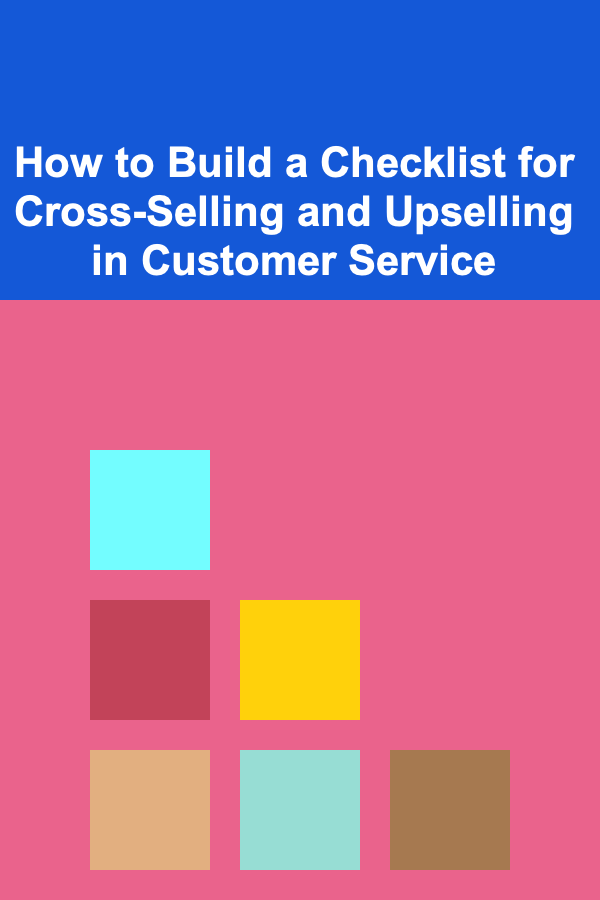
How to Build a Checklist for Cross-Selling and Upselling in Customer Service
ebook include PDF & Audio bundle (Micro Guide)
$12.99$7.99
Limited Time Offer! Order within the next:

In the world of customer service, cross-selling and upselling are two powerful techniques that can significantly enhance revenue while providing added value to customers. When done right, these strategies can lead to better customer satisfaction, loyalty, and increased sales. However, to execute them effectively, it's essential to have a structured approach, and that's where a checklist comes in.
A checklist for cross-selling and upselling ensures that customer service representatives have a clear and consistent process to follow, allowing them to identify opportunities, offer relevant products or services, and ultimately enhance the customer experience. In this actionable guide, we will walk through the key steps to build an effective checklist for these two strategies.
Understand the Difference Between Cross-Selling and Upselling
Before building your checklist, it's important to clearly define the two strategies and understand when to use each:
- Cross-Selling refers to the practice of offering customers additional products or services that complement their original purchase. For example, if a customer is buying a laptop, cross-selling could involve recommending accessories like a carrying case or wireless mouse.
- Upselling involves encouraging customers to purchase a higher-end version of the product or service they are already considering. For example, if a customer is looking at a standard phone model, upselling could involve suggesting a premium model with additional features.
Understanding these distinctions will help you develop a checklist tailored to both strategies.
Identify the Right Opportunities
Effective cross-selling and upselling require identifying the right opportunities at the right time. It's crucial not to overwhelm the customer with irrelevant suggestions. Here's how you can ensure you're targeting the right moments:
Cross-Selling Opportunities:
- After the Initial Purchase Decision: Once the customer has committed to buying a primary product or service, present complementary items. For example, if a customer buys a printer, offer them additional ink cartridges, paper, or a warranty.
- During the Service Interaction: If the customer is asking questions about a product, you can suggest additional items that enhance or support what they're already considering. For instance, if they inquire about a TV, suggest a soundbar or wall mount.
- Post-Purchase Follow-up: After the purchase, you can suggest items that they might need in the future based on their purchase. If a customer buys a smartphone, sending a follow-up email with accessory suggestions can be an excellent cross-sell opportunity.
Upselling Opportunities:
- When the Customer Shows Interest in a Basic Version: If a customer is interested in a standard version of a product, you can highlight the benefits of a premium version. For example, if a customer is looking at a basic gym membership, offer them a premium membership with additional features like personal training or access to exclusive classes.
- When the Customer Is Open to Upgrading: If a customer seems uncertain or expresses concerns about their initial choice, you can present a higher-end product that offers additional value for a small price difference.
- Before the Final Purchase Decision: During checkout, if the customer is already investing in a product, it may be a good time to introduce a slightly higher-priced version of the same product with more features or better quality.
Develop a Clear, Easy-to-Follow Checklist
Now that you understand when and where to use cross-selling and upselling, it's time to create your checklist. A well-designed checklist ensures that customer service agents have a clear, repeatable process for implementing both strategies.
Here's an example of how to structure your checklist:
Cross-Selling Checklist:
-
Assess the Customer's Needs:
- Ask questions to understand the customer's needs and preferences.
- Confirm what products or services they are currently purchasing.
-
Identify Complementary Products:
- Identify products or services that naturally complement the customer's current selection.
- Ensure that these additional items add value to the customer's experience.
-
Introduce the Additional Products:
- Present complementary items in a helpful and non-pushy way.
- Explain how the additional products can enhance or support their current choice.
-
Offer Personalized Suggestions:
- Use customer data (if available) to suggest products that fit the customer's specific preferences or past purchases.
- Ensure the suggestions are relevant and useful to the customer's needs.
-
Highlight Discounts or Promotions:
- If applicable, inform the customer of any special offers or discounts related to the cross-sell.
- Provide value by offering bundled deals or discounts for purchasing multiple items.
-
Be Ready to Address Objections:
- Be prepared to address any hesitations the customer might have about additional purchases.
- Emphasize the benefits and value of the complementary products.
-
Close with Gratitude:
- Thank the customer for their business and assure them that they made the best choice.
- If no cross-sell was made, maintain a positive and helpful attitude for future opportunities.
Upselling Checklist:
-
Understand the Customer's Intent:
- Determine what the customer is primarily interested in.
- Identify whether they are open to considering more advanced or premium options.
-
Present Higher-Value Options:
- Introduce the upsell by highlighting the benefits of a more advanced product or service.
- Focus on the additional features, quality, and long-term value of the premium option.
-
Address the Value Proposition:
- Explain the cost-benefit relationship of the higher-end product.
- Point out how the premium product will solve the customer's needs better or offer more convenience.
-
Introduce Flexible Payment Plans or Financing:
- If the higher-priced item is a concern, offer flexible payment plans or financing options to make the purchase more manageable.
- This reduces the perceived risk of upgrading.
-
Leverage Social Proof:
- Share testimonials or success stories from other customers who have purchased the premium product.
- This creates confidence in the value of the upsell.
-
Highlight Urgency or Limited-Time Offers:
- If applicable, mention time-sensitive offers or bonuses that make the upsell more attractive.
- Be careful not to pressure the customer; urgency should feel natural and helpful.
-
Offer a Trial Period:
- If possible, offer the customer a trial period for the upgraded product.
- This reduces the risk and makes the upsell feel like a less significant commitment.
-
Close with a Thank You:
- Regardless of the customer's decision, thank them for considering the upsell.
- Show appreciation for their time and ensure they are satisfied with their choice.
Train Your Team to Use the Checklist Effectively
Once the checklist is ready, it's essential to ensure that your customer service team understands how to use it effectively. Training your team will ensure that cross-selling and upselling become natural parts of the customer service process, rather than forced or awkward interactions.
Training Tips:
- Role-Playing: Have team members practice using the checklist through role-playing exercises. This helps them get comfortable with the language and techniques involved in cross-selling and upselling.
- Provide Real-Life Examples: Share success stories or real-life examples where cross-selling or upselling worked well. This will give your team a better understanding of how to apply the strategies in real scenarios.
- Focus on Customer-Centric Approaches: Remind your team that both cross-selling and upselling should always benefit the customer. These strategies should enhance the customer's experience, not just drive sales.
- Monitor and Provide Feedback: Regularly review your team's performance and provide constructive feedback. Recognize good practices and offer suggestions for improvement.
Measure Success and Continuously Improve
As with any customer service strategy, it's important to track the effectiveness of your cross-selling and upselling efforts. By measuring the success of your checklist, you can refine your approach over time and ensure continuous improvement.
Key Metrics to Track:
- Conversion Rates: Track how often cross-sell and upsell attempts lead to actual purchases. This will give you a clear picture of how successful your strategies are.
- Customer Satisfaction: Monitor customer feedback to ensure that cross-selling and upselling efforts are not negatively impacting the overall customer experience.
- Revenue Growth: Measure how much revenue is being generated through cross-sells and upsells. This will help you determine if your efforts are contributing to your bottom line.
- Repeat Business: Track whether customers who were upsold or cross-sold return to make additional purchases. This indicates that the added value is being appreciated.
By continuously analyzing the performance of your checklist and making adjustments as necessary, you can maximize the impact of your cross-selling and upselling strategies.
Conclusion
Building a checklist for cross-selling and upselling in customer service is a powerful tool that ensures a structured, effective approach to increasing revenue and customer satisfaction. By understanding when to use each strategy, creating a clear and easy-to-follow process, and training your team effectively, you can unlock the full potential of these techniques. Remember, the key is to always prioritize the customer's needs and offer value---this will lead to greater success for both your business and your customers.
Reading More From Our Other Websites
- [Organization Tip 101] How to Develop a Daily Routine That Works for Remote Work
- [Needle Felting Tip 101] Troubleshooting Tips: Perfecting Your Needle Felting Artwork
- [Home Lighting 101] How to Choose a Home Depot Heat Lamp That Fits Your Aesthetic
- [Home Storage Solution 101] How to Use Baskets and Bins for Organized Storage
- [Personal Care Tips 101] How to Choose an Eye Cream with Natural Ingredients
- [Organization Tip 101] How to Set Up a Kid-Friendly Cooking Drawer
- [Home Maintenance 101] How to Extend the Life of Your Appliances
- [Home Budget Decorating 101] How to Make Your Home Feel Cozy on a Budget
- [Home Soundproofing 101] How to Install a Soundproof Ceiling in Your Home
- [Home Soundproofing 101] How to Soundproof a Ceiling to Prevent Noise from Upstairs

Exploring the Earning Potential of Deep Learning in AI Applications
Read More
How to Make Your Home Safe for Both Pets and Children
Read More
How to Screen Potential Tenants for Your Rental Property
Read More
Photographing the Moon with Your Smartphone: A Comprehensive Guide
Read More
How to Become a Financial Coach for Young Adults
Read More
10 Tips for Finding Free Camping Spots
Read MoreOther Products

Exploring the Earning Potential of Deep Learning in AI Applications
Read More
How to Make Your Home Safe for Both Pets and Children
Read More
How to Screen Potential Tenants for Your Rental Property
Read More
Photographing the Moon with Your Smartphone: A Comprehensive Guide
Read More
How to Become a Financial Coach for Young Adults
Read More